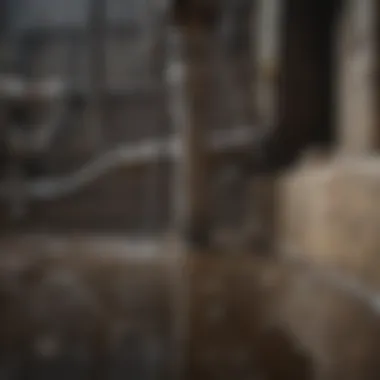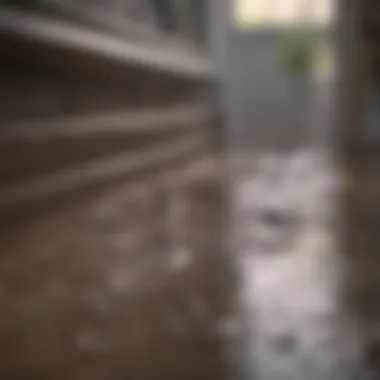Effective Drain Unclogging Strategies for Homeowners


Intro
Clogged drains are a common issue in many households and can cause significant inconvenience. Whether it is a slow sink in the kitchen or a backed-up bathtub, understanding the methods to prevent and address drainage problems is essential. Homeowners often face decisions between DIY methods and hiring professional services. This guide aims to elucidate various strategies to tackle clogged drains effectively.
Here, we will explore a range of options applicable for different scenarios, while also highlighting the tools and techniques needed to achieve results. Issues like grease buildup, hair clogs, or foreign objects obstructing water flow can seem daunting, but with the right knowledge, anyone can manage them efficiently. Furthermore, proactive measures can prevent future blockages, ensuring smooth drainage in the long term.
Let’s delve into effective strategies designed for both novices and experienced individuals aiming to maintain their plumbing systems.
Feature Spotlight
Essential Tools for Drain Maintenance
Maintaining drain health requires understanding and using the right tools. Some essential tools include:
- Plumber's Snake: Useful for removing stubborn clogs deep within pipes.
- Plunger: A basic yet effective tool for many types of blockages.
- Drain Auger: Ideal for long reaches in hard-to-access areas.
- Wet/Dry Vacuum: Can be helpful for pulling out obstructions in basins.
Developing familiarity with these instruments allows homeowners to tackle drain issues confidently.
"Preventive maintenance like regular cleaning can save you from costly repairs in the future."
Chemical Solutions
Chemical drain cleaners can be a quick fix for minor clogs. These substances often contain enzymes or acids that break down debris. However, such products should be used with caution. Over-reliance on these cleaners can lead to pipe damage over time. Always follow instructions precisely, and consider safer alternatives when possible.
Location Highlights
Common Clog Locations
Identifying where clogs frequently occur can greatly aid in prevention and maintenance. Common areas include:
- Kitchen Sink: Clogged due to grease, food scraps, and soap residue.
- Bathroom Sink: Hair and personal care products often lead to blockages.
- Toilet: Improperly disposed items can create significant clogs.
- Showers: Hair buildup is the leading cause.
Understanding these patterns can help homeowners implement regular maintenance and specific preventive measures.
Preventative Measures
To ensure drains remain clear, homeowners should adopt some practices:
- Regular Cleaning: Use boiling water mixed with baking soda and vinegar to break down buildup periodically.
- Hair Screens: Install screens over drain openings to catch hair and debris before it enters pipes.
- Mindful Disposal: Educate family members on appropriate disposal of waste in sinks and toilets.
These strategies reduce the likelihood of blockages and improve the overall drainage system's lifespan.
In the quest for a well-maintained plumbing system, homeowners can benefit from understanding the underlying issues of clogged drains, knowing how to address them, and maintaining focus on prevention.
Understanding Drain Clogs
Drain clogs can disrupt daily living significantly. They affect water flow, causing frustration and potential damage to plumbing systems. By understanding this issue, homeowners and enthusiasts can approach cluttered drains more effectively. Drain clogs do not happen randomly; they often result from specific reasons. Once these causes are identified, tailored strategies can be developed to prevent or resolve related problems. This knowledge will be key in ensuring drainage efficiency.
Common Causes of Clogs
Several factors contribute to the formation of drain clogs. Some of the most frequent causes include:
- Hair: In bathroom sinks and showers, hair is a leading cause of clogs. It can accumulate and bind with soap residue.
- Food Waste: In kitchens, leftover food particles can easily clog drains, especially if they do not decompose quickly.
- Grease: Cooking oils and fats solidify in pipes, causing severe blockages over time.
- Soap Scum: Soap can combine with minerals in water to form a hard residue that can block pipes.
- Foreign Objects: Items such as sanitary products, toys, or even small pieces of dishware can cause clogs when flushed or washed down the drain.
Being aware of these culprits allows individuals to take proactive measures to avoid significant plumbing issues.
Identifying Different Types of Drains
Not all drains are created equal, and their functionalities can vary. It's important to recognize the different types of drains in a home. The main categories include:
- Kitchen Drains: Typically found in sinks and dishwashers, these drains deal with food waste and grease.
- Bathroom Drains: These include sinks, showers, and bathtubs, often cluttered by hair and soap.
- Floor Drains: Common in basements and garages, they collect excess water from mopping or rain.
- Sewage Drains: These take all waste away from the property. Blockages here could signal bigger issues.
Understanding these types of drains is crucial. Each type requires specific care and attention to prevent clogs.


"By preventing clogs, you not only save time and effort but also extend the lifespan of your plumbing."
Preventive Measures
Preventive measures are essential components of maintaining the efficiency of your plumbing system. By adopting effective strategies to avoid clogs before they happen, homeowners can save time, money, and the frustration involved in dealing with blocked drains. Prevention not only reduces the frequency of clogs but also extends the lifespan of your plumbing infrastructure.
Understanding common contributors to clogged drains is vital. Ingredients like grease, hair, soap scum, and food particles accumulate within pipes over time. Therefore, the earlier these are addressed, the less severe the blockage will be. Regular attention to drain care creates a habit of maintenance that is crucial for any homeowner.
Routine Maintenance Practices
Establishing a routine maintenance schedule is one of the fundamental strategies for preventing drainage issues. Simple yet effective tasks should be performed regularly:
- Flush faucets and drains with hot water: Doing this weekly helps dissolve soap and grease that can build up over time.
- Inspect and clean traps: Kitchen and bathroom sinks usually have traps that catch debris. Regular cleaning keeps these areas clear.
- Check for slow drains: If you notice water pooling in the sink or tub, it’s advisable to address it immediately.
Incorporating these practices ensures that minor issues do not escalate into major problems. Engaging in routine maintenance fosters a proactive approach to drain care.
Best Practices for Kitchen Drains
Kitchens are hotspots for potential clogging due to the food waste and grease that often enter these drains. Implementing best practices specific to kitchen drains can substantially reduce the risk of blockages:
- Use a sink strainer: This device catches food particles and debris before they enter the drain. It is easier to clean than dealing with a full clog.
- Avoid pouring grease down the drain: Let the grease cool and then dispose of it properly in the trash rather than washing it away. This practice prevents solidification in the pipes.
- Run the garbage disposal correctly: It’s crucial to only use the disposal for food scraps that it can handle. Non-food items should never enter the disposal, and large scraps should be cut into smaller pieces.
By adhering to these practices, you cultivate a drain-friendly kitchen environment.
Tips for Bathroom Drain Protection
The bathroom often presents unique challenges, predominantly due to hair and personal hygiene products. To protect your bathroom drains, consider the following tips:
- Install hair catchers: Placing a catcher in the shower or bathtub can collect hair before it enters the drain.
- Be cautious with toiletries: Avoid rinsing or flushing items such as cotton balls, cotton swabs, or wipes, as they can accumulate and form blockages.
- Educate household members: Everyone in the home should know what can and cannot go down the drains. Awareness is essential in preventing clogs from occurring.
In summary, preventing drain clogs requires a multifaceted approach with regular maintenance practices, specific attention to kitchen habits, and bathroom hygiene. Commitment to these preventative measures can significantly enhance the health of your plumbing and keep your drains clear.
Tools for Unclogging Drains
Understanding the various tools for unclogging drains is crucial. Different situations often demand different approaches, and having the right tools at your disposal can significantly enhance efficiency. Utilizing appropriate tools not only helps in addressing the immediate problems but also contributes to maintaining the long-term functionality of your drainage systems. Knowing which tools to use for specific types of clogs allows you to take control of your plumbing issues more effectively.
Essential Hand Tools
Several hand tools are essential for effective unclogging. A toolbox should include the following items:
- Wrench: A pipe wrench is important to adjust or tighten plumbing fixtures.
- Screwdriver: Both flathead and Phillips types can be necessary for removal of various fittings.
- Plumber’s tape: This helps in sealing joints and preventing leaks during repairs.
- Bucket: Always have a bucket on hand to catch water that might spill during the unclogging process.
Each of these tools plays a role in making the unclogging process smoother and preventing further damage to your plumbing.
Plumbing Snakes and Augers
Plumbing snakes, often called drain snakes, are specialized tools designed for clearing stubborn clogs deep within pipes. They come in various lengths and diameters to suit different types of plumbing challenges. You can find manual snakes for smaller clogs and powered augers for more significant blockages. These tools are capable of reaching further into the drain pipes, effectively breaking up and removing blockages that might not respond to simpler methods.
Using a plumbing snake requires a little practice. Insert it slowly into the drain. Rotate the handle clockwise to enable the tool to coil into the blockage. This action will help break it apart, allowing you to pull out debris or push it through the pipes for eventual removal. Ensuring you have a few different sizes on hand can make a big difference, as well.
Using a Plunger Effectively
A plunger is often the first tool homeowners reach for when faced with a clog. This tool operates primarily on high-pressure air to dislodge obstructions near the drain's entrance. To use it effectively, ensure that there is enough water in the sink or toilet bowl to cover the plunger’s cup. The next step involves a firm and steady motion, repeatedly pushing and pulling. This method can create suction that loosens the clog.
While it may seem simple, proper technique is key. Take your time and focus on maintaining a seal between the plunger and the drain. This will enhance the effectiveness of the process.
Consumer Drain Cleaning Products
Various consumer drain cleaning products are readily available on the market. They offer a chemical solution to tough clogs and can be quite effective in certain cases. Common types include:
- Enzymatic cleaners: These use enzymes to break down organic material.
- Acidic cleaners: Typically used for tougher clogs, these can dissolve hair and grease.
- Alkaline cleaners: Useful for breaking down protein-based clogs, such as food debris.
When opting for chemical solutions, always read the labels carefully. Following manufacturer instructions is vital to ensure safety and effectiveness. Additionally, know that some chemicals can damage older pipes, so it is essential to weigh this risk before use.


Always consider starting with safer methods before resorting to harsh chemicals.
The tools and methods you choose significantly influence your success in unclogging your drains. Each tool has its function, providing specific advantages for various situations. Being equipped with the right knowledge and equipment means you can handle most drainage issues efficiently.
DIY Unclogging Techniques
DIY unclogging techniques are valuable methods for homeowners. They have the potential to save not only money but also time when dealing with common drain issues. Many clogs can be resolved using simple household items. These techniques prevent escalation, reducing the need for professional help. Understanding these methods enhances the homeowner's ability to maintain plumbing efficiency.
Hot Water Method
The hot water method is one of the easiest approaches. Boiling water can dissolve many types of blockages. This is particularly effective for grease build-up that often occurs in kitchen drains.
To use this method:
- Boil a pot of water.
- Carefully pour the hot water down the drain in stages. This allows the water to break down the grease or debris progressively.
This technique is most effective when combined with other methods, such as using a plunger afterward to help move along anything that remains.
Baking Soda and Vinegar Approach
Mixing baking soda and vinegar creates a powerful chemical reaction. This method works well against foreign objects and organic matter. The fizzing action helps to dislodge clogs.
To perform this method, you should:
- Pour a cup of baking soda into the drain.
- Add a cup of vinegar. Allow it to sit for about 30 minutes.
- Rinse with hot water.
The bubbling reaction helps eliminate stubborn blockages. This method is also environmentally friendly, making it a preferred choice for many homeowners.
Using Dish Soap
Dish soap is often overlooked as a drain cleaner. However, it can effectively break down grease that clogs kitchen drains. When used in conjunction with hot water, it can be very effective.
To apply this method:
- Pour a generous amount of dish soap down the drain.
- Follow it with hot water. This should help the soap break down any greasy build-up.
This technique is beneficial because it is safe for pipes and can be done quickly. Overall, it is a simple yet effective option for maintaining healthy drainage.
Remember to combine DIY methods for better results. Using them in succession can tackle severe clogs effectively.
When to Call Professionals
Recognizing when to engage professional services is vital in maintaining the health of your drainage system. While many clogs can be resolved with DIY techniques, some situations reveal the need for skilled intervention. Understanding the limits of your capabilities is key to preventing further damage.
Certain signs indicate that a clog may require professional help. Persistent water backing up despite multiple attempts at unclogging can signify an issue deeper in the plumbing system. In such cases, professional plumbers possess the technology and techniques necessary to address serious blockages.
Additionally, experts can provide a thorough inspection. They can identify issues that may not be visible to the untrained eye. Understanding potential underlying problems can save homeowners from costly repairs in the future. Employing professionals ensures that the root cause of the clog is addressed rather than only treating the symptoms.
"Ignoring persistent plumbing issues can lead to more severe damage and greater expenses in the long run."
Assessing Severity of the Clog
To determine if a clog is severe enough to necessitate professional help, consider several factors. First, observe how long the clog has been present. A clog persisting beyond a few hours likely indicates a more profound issue.
Next, monitor the performance of other drains in the home. If multiple areas are affected, this may suggest a larger systemic problem. Additionally, consider the type of materials causing the obstruction. Clogs resulting from solid objects may require specialized tools to remove them safely.
Homeowners should also note any accompanying signs of plumbing issues. Unpleasant odors or abnormal sounds from the pipes can indicate a more significant plumbing failure. If these signs are present along with persistent clogs, it is prudent to call a professional.
Evaluating DIY Failure
When attempting to clear a clog, not every DIY approach will be successful. It is crucial to evaluate the effectiveness of the methods used. If a homeowner has tried several tactics, such as plunging or using chemical solutions, without success, this could be a clear signal to seek professional assistance.
Moreover, assess the safety of the chemicals used. Some drain cleaners can damage plumbing if misused, leading to further complications. If a homeowner has to resort to more extreme measures, it is best to consult with an expert.


In taking these considerations into account, homeowners can gauge whether their efforts have been insufficient or inappropriate. Recognizing when to step back can save time and prevent further damage.
Professional Unclogging Services
Professional unclogging services play an essential role in resolving drain-related issues that exceed the capabilities of DIY methods. The need for these services arises primarily from the complexity of some clogs, which may involve severe blockages or underlying plumbing problems that require specialized knowledge and equipment.
Hiring professionals ensures that the issue is addressed effectively. They bring experience that allows them to quickly diagnose and resolve clogs without causing damage to the plumbing system. Many homeowners try to clear clogs on their own, often leading to further complications. In contrast, professionals evaluate and apply the appropriate methods, protecting the integrity of the pipes.
Understanding Service Options
When considering professional unclogging services, it is vital to understand the different options available in the market. Services can range from simple drain cleaning to extensive plumbing repairs. Here are some common types of services:
- Drain Cleaning: This involves using specialized tools to remove debris, grease, and other buildup within pipes.
- Camera Inspection: A video camera is used to inspect the insides of pipes, identifying the cause of persistent clogs.
- Hydro Jetting: A high-pressure water jet is utilized to clear out severe clogs and restore pipes to optimal flow.
- Rooter Services: This involves addressing tree roots or other vegetation that may have intruded into the drainage system.
Understanding these services equips homeowners to ask informed questions and choose the right option based on their specific needs. Before hiring, it is prudent to check certifications and reviews to ensure the selected service is reliable.
Costs Associated with Professional Help
The costs of hiring professional unclogging services can vary significantly based on several factors. Homeowners should consider the following:
- Severity of the Clog: Complex issues may require more time and resources, increasing labor costs.
- Type of Service: Specialized services like hydro jetting often come at a higher price compared to standard drain cleaning.
- Location: Prices can differ based on geographical area and availability of services.
- Additional Repairs: If the inspection reveals underlying problems, repair costs may add to the overall expense.
Generally, homeowners can expect to pay anywhere from $100 to $300 for basic unclogging services. More extensive issues, particularly those requiring camera inspections or hydro jetting, can cost upwards of $500 or more.
"Understanding the scope of work can help homeowners manage expectations and budget accordingly."
Being informed about the potential costs and services available helps in making sound decisions and ensures that the plumbing system remains functional and efficient in the long run.
Long-Term Drain Solutions
Long-term drain solutions are essential for maintaining the efficiency and integrity of your plumbing system. Addressing drainage issues is not just about dealing with immediate problems; it also involves implementing strategies that prevent future clogs and costly repairs. These solutions not only enhance the longevity of the drainage system but also improve overall hygiene and comfort within the home.
Investing in Drain Screens and Traps
Investing in drain screens and traps is one of the most effective long-term solutions for preventing clogs. These devices act as barriers that intercept hair, soap, food particles, and other debris before they can enter the drainage system.
- Ease of Cleaning: Drain screens need regular cleaning, but the effort is minimal compared to dealing with blocked drains.
- Reduced Repair Costs: By preventing clogs, you reduce the chances of expensive plumbing repairs or emergencies.
- Variety: Screens and traps come in various designs suited for kitchens, bathrooms, or laundry areas, enabling targeted protection where it is needed most.
- Increased Drainage Capacity: By capturing debris, these devices help maintain the flow of water, leading to more efficient drainage overall.
It is important to choose the right type of screen or trap for each drain. For instance, fine mesh screens are useful in catching small particles, while larger traps can accommodate chunky debris typical to kitchen drains.
Regular Professional Inspections
Regular professional inspections are vital in maintaining a healthy drainage system and preventing future issues. This practice involves scheduling routine assessments by experienced plumbers who can identify potential problems early on.
- Early Detection: Professionals can spot signs of wear, corrosion, or other issues that might lead to more severe clogs if left unchecked.
- Expert Recommendations: During inspections, plumbers can provide tailored advice on maintenance practices specific to your household needs.
- Systematic Maintenance: Regular checks enhance the overall efficiency of the plumbing system, reducing the frequency of emergency repairs and costly downtime.
- Investing in Future: By prioritizing inspections, homeowners ultimately save on future repair costs and ensure the plumbing remains in good working order.
It is advisable to schedule these inspections at least once a year, though more frequent check-ups may be required for older homes or those with complex plumbing systems.
Taking proactive steps, such as investing in drain screens and scheduling regular inspections, can significantly extend the life of your drainage system, protect your property, and enhance overall quality of life.
Closure: Best Practices for Drain Maintenance
In addressing drain maintenance, several critical elements come into play. It is not only about resolving existing clogs but also about implementing effective practices to prevent future issues. Given the complexity of household plumbing systems, maintaining drainage systems optimally is a necessity for homeowners. This section synthesizes the information discussed in the article, highlighting best practices that can save time, money, and frustration.
Summary of Effective Techniques
Successful drain maintenance begins with consistent and proactive strategies. Here are effective techniques that homeowners should consider integrating into their routines:
- Regular Cleaning: Utilizing hot water to flush drains periodically can help in removing grease and debris before they accumulate and cause serious blockages.
- Using Drain Screens: Installing screens in kitchen sinks and bathroom drains can capture hair, food particles, and other debris, allowing free-flowing water and minimizing buildups.
- Baking Soda and Vinegar: This natural method effectively maintains drain health. A monthly application can dissolve scum and prevent unpleasant odors.
- Avoiding Chemical Drain Cleaners: Overuse of these substances can corrode pipes over time. It is more sustainable to rely on biodegradable options or mechanical tools.
Adopting these practices will ensure that most drainage issues are kept in check before they escalate.
Future Considerations for Homeowners
Homeowners must remain informed about their plumbing systems and evolving maintenance techniques. As installations and products improve, new methodologies may emerge to enhance drain efficiency. Key considerations include:
- Investing in Quality Fixtures: Choosing high-quality plumbing fixtures can reduce the risk of clogs and extend the life of the plumbing system.
- Regular Inspections: Engaging professionals for periodic assessments allows for identifying potential issues before they require expensive repairs.
- Staying Informed: Knowledge is vital. Homeowners should educate themselves about their specific plumbing setup and best practices for upkeep. Online resources, professional advice, and community discussions can be invaluable.
"Routine maintenance is not just about keeping water flowing; it’s about ensuring the longevity and efficiency of your entire plumbing system."







